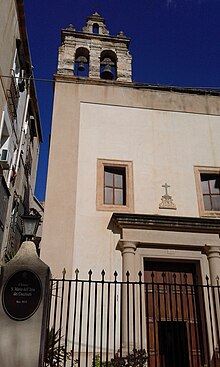Via Alloro (Palermo)
The Via Alloro is a street in the district of Kalsa the Sicilian city of Palermo . It runs from Via Torremuzza and Via Butera to Via Allessandro Paternostro and Via Aragona and forms a link between the sea and the center of the historical Kalsa district. It used to be called Ruga Magistra , meaning main street . It has its origins in Arab times, when it connected the fortress of Al-Halisah with the rest of the city.
Surname
It owes its current name to a laurel tree in the garden of the Pallazzo Bellacera, today's Palazzo S. Gabriele . According to a report by the prince and historian Villabianca, it was felled on December 4, 1704, the day of Saint Barbara .
Development
The street still forms the main axis of the Kalsa district today. The richest and most influential nobles of the city lived here in close concentration. Various palazzi are located here, including the Palazzo Abatellis , which is now the Galleria Regionale della Sicilia , the Palazzo Calvello , Palazzo Diana di Cefala , Palazzo Bonagia - which was almost completely destroyed in the Second World War, the Palazzo S. Gabriele and the Hotel Patria . Since the 19th century, the nobles increasingly left their palaces and moved to more attractive areas. In return, more and more poor people came and inhabited the palazzi, which were increasingly exposed to decay.
In the street are the churches of Madonna dell'Itria alla Kalsa and Santa Maria degli Angeli , also known today as Gancia, in whose former convent building a department of the State Archives has been housed since 1859.
Web links
Information in Palermoviva (Italian)
literature
Giuseppe Bellafiore: Palermo. Guida della Città e dei dintorni , Palermo 2002, p. 72

